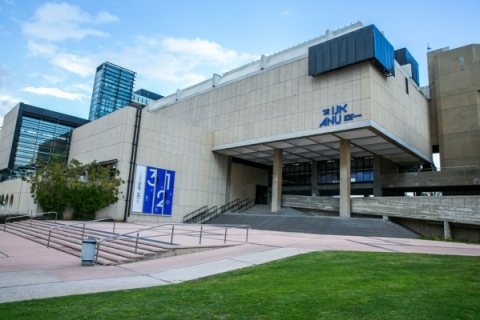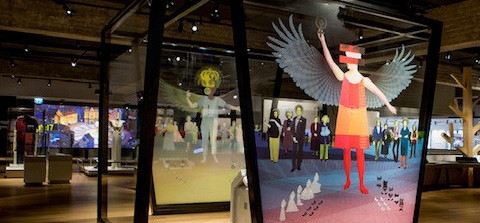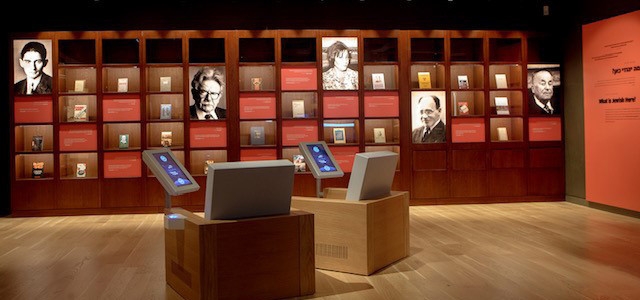Our Story – The new ANU Museum
I have lived in Israel long enough to remember the1978 opening of Beit Hatfutsot, the Nahum Goldmann Museum of the Diaspora. With enormous excitement, I spent a day wandering around the newly opened building, overwhelmed by what was then the last word in modern museums. I visited Beit Hatefutsot many times after that, particularly to show it off to visitors from overseas and it never failed to move me.
Time passed, and both the museum and I aged.
Now, Beit Hatfutsot has been updated and replaced by something more suited to the times. No longer focused on the diaspora, it now aims at comprehension: the Jewish people in all its variety. The result is an image and name change to ANU ("We") Museum of the Jewish People.
Opened in March, the update cost $100 million and is triple the size of the original museum at more than 6,000 square meters. It features 50 films, 25 interactive exhibits, recordings, art and more. Just as in 1978, I was moved by 2021's version of the last word in museums.
The aim of ANU is "celebrating Jewish diversity and communities and showing how Jewish identity and culture have evolved over time" – a daunting task. It's impossible to include everything and no doubt many people will feel that their personal backgrounds have been given short shrift. That is inevitable. The exhibits are eclectic, to say the least, and often surprising, though always interesting.
One does get the feeling that deciding what to include and what to leave out seems to have been decided by a committee. In fact, it was: some 50 academic advisers, curators and experts were involved, to make sure that all genders, ethnicities and denominations were well represented.
For example, a showcase featuring an amusing poem about modern kapparot, including such sins to be atoned for as the sin of sharing everything on Facebook, the sin of constant dieting and the sin of not calling parents (are you listening, kids?), stands next to an archaeological stone capital and an art work about Kabballah. There are real-life artifacts, such as Isaac Bashevis Singer's typewriter and a guitar owned by Leonard Cohen as well as contemporary art, not copies.
In spite of its variety, I found ANU to be more historical and factual (in a good way) and less message-driven than the former museum.
Among the changes is a more muted focus on the Holocaust; less emphasis on Israel as the ultimate homeland for all Jews; and stories of people that would never have been featured in Beit Hatfutsot, such as intermarried and gay couples. A Reform rabbi for example, explains that she is a lesbian who came out at age 20. Women now figure prominently everywhere.
The museum exhibits begin with a conceptual presentation of Foundations, by which is meant a common core and universal message that is both Jewish and universal. The Jewish foundation, of course, is the Bible. Exhibits relate to the Jewish calendar, rites of passage, the influence of the Bible on world culture and the synagogue.
Here are the famous models of synagogues around the world that were retained from the older museum. Alongside each model, an original ritual artifact, either from the synagogue or its respective community, is on display. Through these items, the visitor can learn more about the cultural and artistic identity of each specific community. The artifacts include historical Judaica, prayer books, publications, as well as an impressive stained-glass window created in Germany in 1919 by the artist Friedrich Adler.
Anti-Semitic art is part of it too. There are replicas, for example, of statues of Synagoga and Ecclesia, which can be found even today on cathedrals in Europe. Synagoga is a representation of a woman wearing blinders, indicating Jews who are blind to the sovereignty of Christianity, which by way of contrast. is represented by Ecclesia, wearing a triumphant crown.
Tucked away in a corner of the synagogue room is a fascinating interactive display at which I spent a happy half hour listening to different versions of piyyutim from around the world. (Who knew Indian Jews had such a charming melody for Adon Olam?) Included among the recordings of traditional chazzanut are less traditional, but well-loved versions of Barbara Streisand's Avinu Malkeinu, Leonard Cohen's Unetane Tokef song, "Who By Fire" and Yasmin Levy's Yigdal. I was pleased to see that the synagogue section also included a display of that very important part of the synagogue experience – people fressing at a kiddush.
The second floor is devoted to "The Journey", a chronological story of the Jewish people from biblical and Babylonian times to an explanation of Ashkenazim and Sephardim, through to the modern era, with its issues of integration, modernity, and urbanization. The Holocaust is marked simply, by a display in a small darkened room of an art work featuring the iconic photograph of the small boy holding his hands in the air by artist Gustav Metzger, with a pile of rubble beneath the photograph.
The third and final floor is titled "A Mosaic" and is arranged by themes, such as Being Jewish Today, Folklore, My Hero, Women Trailblazers and others, including the Jewish contribution to various arts – film, dance, comedy, etc. Of course, there is a display of information about famous Jews, but also quirkier, less famous ones, such as Angelica Rozann Adelstein – a table tennis champion from Romania, Monsieur Chochani – a 20th century scholar from Uruguay and Moshe Cohen Henriques – a 17th century pirate. There is also a picture of Franz Sacher, who invented that great contribution to world gastronomy, Sachertorte.
Displays on Jewish communities today and Israel mark the end of the story, at least for now.
What of the future for the Jewish people? The museum makes no predictions. But judging by the vigor, the accomplishments, and the ups and downs of the past that are on display in the ANU museum, it is sure to be interesting.
ANU Museum of the Jewish People. Museum opening Hours
Sunday-Wednesday 10 am – 7 pm
Thursday 10 am – 10 pm
Friday 9 am – 2 pm
Saturday 10 am – 5 pm
Entry fees:
Regular NIS 52
Seniors NIS 26
People with disabilities, college students, olim NIS 39
Children under 5 and soldiers in uniform free










Comments